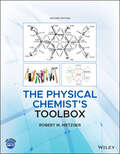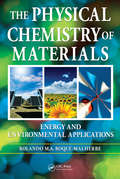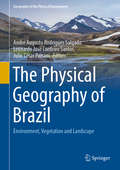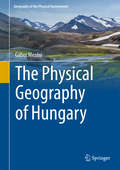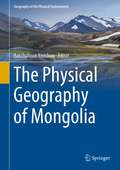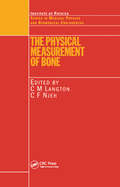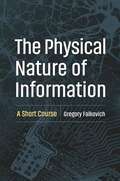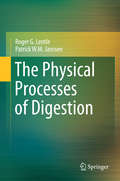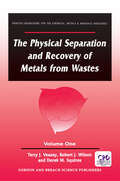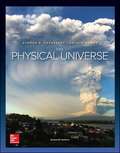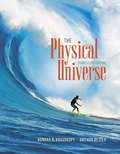- Table View
- List View
The Physical Basis of Biochemistry
by Peter R. BergethonBiological chemistry has changed since the completion of the human genome project. There is a renewed interest and market for individuals trained in biophysical chemistry and molecular biophysics. The Physical Basis of Biochemistry, Second Edition, emphasizes the interdisciplinary nature of biophysical chemistry by incorporating the quantitative perspective of the physical sciences without sacrificing the complexity and diversity of the biological systems, applies physical and chemical principles to the understanding of the biology of cells and explores the explosive developments in the area of genomics, and in turn, proteomics, bioinformatics, and computational and visualization technologies that have occurred in the past seven years. The book features problem sets and examples, clear illustrations, and extensive appendixes that provide additional information on related topics in mathematics, physics and chemistry.
The Physical Chemist's Toolbox
by Robert M. MetzgerThe working tools of the physical sciences, expertly organized into one volume Covering the basic concepts and working tools in the physical sciences, this reference is a unique, indispensable guide for students and researchers in chemistry, physics, and related disciplines. Everyone from novices to experienced researchers can turn to this book to find the essential equations, theories, and working tools needed to conduct and interpret contemporary research. Expertly organized, the book. Summarizes the core theories common to chemistry and physics Introduces topics and techniques that lay the foundations of instrumentation Discusses basic as well as advanced instrumentation and experimental methods Guides readers from crystals to nanoparticles to single molecules Readers gain access to not only the core concepts of the physical sciences, but also the underlying mathematics. Among the topics addressed are mechanics, special relativity, electricity and magnetism, quantum chemistry, thermodynamics, electrochemistry, symmetry, solid state physics, and electronics. The book also addresses energy and electrical sources, detectors, and algorithms. Moreover, it presents state-of-the-technology instrumentation and techniques needed to conduct successful experiments. Each chapter includes problems and exercises ranging from easy to difficult to help readers master core concepts and put them into practice. References lead to more specialized texts so that readers can explore individual topics in greater depth. The Physical Chemist's Toolbox is recommended not only as a general reference, but also as a textbook for two-semester graduate courses in physical and analytical chemistry.
The Physical Chemist's Toolbox
by Robert M. MetzgerAssembling a great deal of material in one place, this book serves as a valuable guide for chemists and related physical scientists throughout their careers -- covering essential equations, theories, and tools needed for conducting and interpreting contemporary research. Offers a comprehensive and in-depth treatment of the most challenging concepts of chemistry Updates and revises existing chapters from the prior edition and adds: new chapters on inorganic, organic, and biochemistry; appendices about nuclides and organic reactions; and expanded questions at the end of chapters Has a complementary website with a solutions manual and PowerPoint presentations for instructors
The Physical Chemistry of Materials: Energy and Environmental Applications
by Rolando Roque-MalherbeIn recent years, the area dealing with the physical chemistry of materials has become an emerging discipline in materials science that emphasizes the study of materials for chemical, sustainable energy, and pollution abatement applications. Written by an active researcher in this field, Physical Chemistry of Materials: Energy and Environmental Appl
The Physical Geography of Brazil: Environment, Vegetation and Landscape (Geography of the Physical Environment Ser.)
by André Augusto Rodrigues Salgado Leonardo José Cordeiro Santos Julio César PaisaniThis book presents the Brazilian natural space and environment. It describes the main environmental aspects of Brazil in relation to geology, climate, geomorphology, vegetation, fauna, water resources and environmental issues. The book presents a beautifully illustrated overview of the physical geography of the Amazon Forest, the central Brazilian savannah (Cerrado), the Cocais Forest, the semi-arid area (Caatinga), the Atlantic Forest area, the Pantanal (Brazilian wetlands), the Auraucárias Plateau, the Pampas area (South grasslands) and the Brazilian Coastal Environment (beaches and mangroves).
The Physical Geography of Hungary
by Gábor MezősiThis book presents the most comprehensive and detailed overview of the physical environment of Hungary. The book makes a specific effort to connect regional geography with natural forcing and influencing factors. The first section discusses general characteristics relating to the physical geography of Hungary on a more theoretical basis including relief evolution, climate, hydrography, soils and vegetation. The second part focuses on regional content and analyzes conflicts, environmental values, threats and impacts of the different geographical units. This book appeals to researchers as well as students of physical geography and related disciplines and serves as a useful source for regional information on Hungary. This book can also be used as a field guide of the physical properties of this European country.
The Physical Geography of Mongolia (Geography of the Physical Environment)
by Batchuluun YembuuThis book gives the most detailed and comprehensive physico-geographical overview of the very unique country of Mongolia. The country offers diverse geographical features and natural landscapes combined with a long history. This book offers integrated and systematical research on the geophysical characteristics of Mongolia with an academic orientation. It provides the readers with general knowledge of the physical geography of Mongolia as well as new results of the latest research. The volume consists of 11 chapters, each written by field experts, with contributions from scientific researchers from Mongolia.The topics covered: geological and geomorphological characteristics and processes, landscapes and landforms, climate and climate change, hydrology, glaciers and permafrost, soils, environmental changes, biodiversity and many other aspects of physical geography in Mongolia.The book appeals to researchers and students of geography and related fields and can serve as a guide for field trips to Mongolia or basic literature for research projects.
The Physical Measurement of Bone
by C. M. Langton C. F. NjehBone is a complex biological material that consists of both an inorganic and organic phase, which undergoes continuous dynamic biological processes within the body. This complex structure and the need to acquire accurate data have resulted in a wide variety of methods applied in the physical analysis of bone in vivo and in vitro. Each method has it
The Physical Nature of Information: A Short Course
by Gregory FalkovichApplications of information theory span a broad range of disciplines today. This book presents a unified treatment of the subject for students and practitioners in the sciences. It teaches the tools universally used by physicists working on quantum computers and black holes, engineers designing self-driving cars, traders perfecting market strategies, chemists playing with molecules, biologists studying cells and living beings, linguists analyzing languages, and neuroscientists figuring out how the brain works. No matter what area of science you specialize in, The Physical Nature of Information unlocks the power of information theory to test the limits imposed by uncertainty. Provides a panoramic approach to information theory Draws on examples from physics, engineering, biology, economics, and linguistics Applications range from thermodynamics and statistical mechanics to dynamical chaos, information and communication theories, and quantum information Includes materials for lectures and tutorials along with exercises with detailed solutions Can be used to design a one-semester introductory course Ideal for self-study by graduate students and advanced undergraduates Invaluable for scholars seeking new research opportunities
The Physical Processes and Observing Techniques of Radio Astronomy: An Introduction (Undergraduate Lecture Notes in Physics)
by Thomas G. PannutiThis is a textbook for undergraduate courses on radio astronomy. Written by an active professor and researcher in the field, it begins by explaining why conducting observations at radio frequencies is so important, then reviews essential physics concepts corresponding to a sophomore-level curriculum or higher. Next, the book introduces students to single dish telescopes and interferometers. The most commonly encountered emission mechanisms seen in radio astronomy are then explained, along with examples of astronomical sources broadly divided into the types of sources seen in galactic and extragalactic observations. Each chapter provides examples and exercises suitable for homework assignments. Also included is an appendix of useful supplementary material. Altogether, the book is a comprehensive, yet digestible starting point for physics and astronomy undergraduates looking to understand the basics of radio astronomy.
The Physical Processes of Digestion
by Roger G. Lentle Patrick W.M. JanssenFood research (and funding) is becoming more and more focused on health. While researchers and product developers have made great strides in food engineering, there needs to be increased focus on what happens when the food is actually digested. How is the food absorbed? Do the benefits remain? Digestion is a complex topic, and this will be the first book aimed at food researchers. Authored by a physiologist and a food engineer, the book will be a welcome addition to the literature.
The Physical Separation and Recovery of Metals from Waste, Volume One
by Alan VeaseyThis book deals with the physical processes used for the separation of secondary metals from waste sources. The introduction briefly considers the history of the secondary metals industries, defines the terms used in materials recycling and discusses the potential for resource recovery and improved processing. A comprehensive survey is given of the
The Physical Universe
by Konrad B. Krauskopf Arthur BeiserThe Physical Universe, 16e by Konrad Krauskopf and Arthur Beiser is an outstanding text with a long history that has been updated and given a fresh look. This edition is also accompanied by a strong media component with the Connect online homework system and LearnSmart Smartbook. Aimed at presenting the essentials of physics, chemistry, earth science, and astronomy in a clear, easy-to-understand way, The Physical Universe shows students how science works, how scientists approach problems, and why science constantly evolves in its search for understanding.
The Physical Universe (14th Edition)
by Konrad B. Krauskopf Arthur BeiserThis is an outstanding text with a long history that has been updated and given a fresh look. The Physical Universe is also accompanied by strong media component with the Connect online homework system, personal response system ("clicker") questions, more extensive online quizzing, and PowerPoint lectures. Aimed at presenting the essentials of physics, chemistry, earth science, and astronomy in a clear, easy-to-understand way,The Physical Universe shows students how science works, how scientists approach problems, and why science constantly evolves in its search for understanding. The text can also be packaged with its long time companion student study guide, which includes a review of chapter terms and concepts; self quizzing for extra practice; and additional solved problems.
The Physical World: An Introduction to Physical Science (formerly Basic Science)
by David Hurd Donovan Hadaway John E. Jenkins George Mulfinger Jr.Physical Science encourages students to see matter and energy as part of God's creation. Students first study elementary chemistry, discussing the structure and interactions of matter and defining chemical and nuclear energy. Then they focus on elementary physics and the other six forms of energy. This is a laboratory course that includes many hands-on experiments and demonstrations.
The Physical and Mathematical Foundations of the Theory of Relativity: A Critical Analysis
by Antonio Romano Mario Mango FurnariThis unique textbook offers a mathematically rigorous presentation of the theory of relativity, emphasizing the need for a critical analysis of the foundations of general relativity in order to best study the theory and its implications. The transitions from classical mechanics to special relativity and then to general relativity are explored in detail as well, helping readers to gain a more profound and nuanced understanding of the theory as a whole. After reviewing the fundamentals of differential geometry and classical mechanics, the text introduces special relativity, first using the physical approach proposed by Einstein and then via Minkowski’s mathematical model. The authors then address the relativistic thermodynamics of continua and electromagnetic fields in matter – topics which are normally covered only very briefly in other treatments – in the next two chapters. The text then turns to a discussion of general relativity by means of the authors’ unique critical approach, underlining the difficulty of recognizing the physical meaning of some statements, such as the physical meaning of coordinates and the derivation of physical quantities from those of space-time. Chapters in this section cover the model of space-time proposed by Schwarzschild; black holes; the Friedman equations and the different cosmological models they describe; and the Fermi-Walker derivative. Well-suited for graduate students in physics and mathematics who have a strong foundation in real analysis, classical mechanics, and general physics, this textbook is appropriate for a variety of graduate-level courses that cover topics in relativity. Additionally, it will interest physicists and other researchers who wish to further study the subtleties of these theories and understand the contemporary scholarly discussions surrounding them.
The Physician's Guide to Delusional Infestation
by Gale E. RidgeThis unique, ground-breaking book is a comprehensive clinical guide to the psychiatric disorder of Delusional Infestation (DI). DI is a psychiatric illness characterized by patients holding a monothematic fixed belief of infestations on their skin, body, or immediate environment - a belief that is not supported by objective medical evidence. Delusional beliefs may be shared among individuals, and perceived pathogens include living organisms such as parasitic worms, bacteria, fungi, and insects. Organic or non-organic infiltration by fibres, threads, or other inanimate particles or objects, known or unknown to medical science, are also described by patients. DI is severely underreported because of social stigma, limited physician awareness, and patient doctor-hopping.Written for physicians, the book offers a multidisciplinary, compassionate care model for patients burdened by this pernicious disorder. Other health professionals and administrators will find the work highly valuable, as will professionals in fields such as veterinary medicine, pest management, entomology, parasitology, and information services supported by academia.The Physician’s Guide to Delusional Infestation assembles and organizes all current knowledge of DI and presents material in three parts. Part I introduces and reviews DI’s historical background, showing how our understanding of the condition has developed. Its concise sections include useful tables, illustrations, algorithms, and reference lists for clinicians who work with DI patients.Part II covers differential diagnosis, treatment, and ways to work effectively with DI patients. Since these patients are often high-functioning, particular techniques of interviewing, joining with patients, sampling, and laboratory testing are explained. International travel, physician fallibilities, possible alternative diagnoses, the Internet, and veterinary and public health concerns are all addressed.PartIII is a series of chapters written by experts in their fields. This section allows each author to present personal experiences from their respective professions -- observations and opinions that show a variety of perspectives among the book’s authors. Part III includes a chapter on common human parasites with their biology, behaviours, and distributions. The book will serve as a comprehensive, yet concise, reference for physicians whose patients have unusual, baffling, or implausible medical histories and physical examinations. A soon to be gold-standard resource, The Physician’s Guide to Delusional Infestation equips and empowers all physicians -- and many others interested in the topic -- with an expert, comprehensive understanding of this complex disorder.
The Physicist and the Philosopher
by Jimena CanalesOn April 6, 1922, in Paris, Albert Einstein and Henri Bergson publicly debated the nature of time. Einstein considered Bergson's theory of time to be a soft, psychological notion, irreconcilable with the quantitative realities of physics. Bergson, who gained fame as a philosopher by arguing that time should not be understood exclusively through the lens of science, criticized Einstein's theory of time for being a metaphysics grafted on to science, one that ignored the intuitive aspects of time. The Physicist and the Philosopher tells the remarkable story of how this explosive debate transformed our understanding of time and drove a rift between science and the humanities that persists today.Jimena Canales introduces readers to the revolutionary ideas of Einstein and Bergson, describes how they dramatically collided in Paris, and traces how this clash of worldviews reverberated across the twentieth century. She shows how it provoked responses from figures such as Bertrand Russell and Martin Heidegger, and carried repercussions for American pragmatism, logical positivism, phenomenology, and quantum mechanics. Canales explains how the new technologies of the period--such as wristwatches, radio, and film--helped to shape people's conceptions of time and further polarized the public debate. She also discusses how Bergson and Einstein, toward the end of their lives, each reflected on his rival's legacy--Bergson during the Nazi occupation of Paris and Einstein in the context of the first hydrogen bomb explosion.The Physicist and the Philosopher reveals how scientific truth was placed on trial in a divided century marked by a new sense of time.
The Physicist's World: The Story of Motion & the Limits to Knowledge
by Thomas Grissom“A clear and succinct account of what physics fundamentally explains about the universe” (Choice).How do students learn about physics without picking up a 1,000-page textbook chock-full of complicated equations? The Physicist’s World is the answer. Here, Thomas Grissom explains clearly and succinctly what physics really is: the science of understanding how everything in the universe moves.From the earliest efforts by Pre-Socratic philosophers contemplating motion to the principal developments of physics through the end of the twentieth century, Grissom tells the unfolding story of our attempt to quantify the material world and to conceptualize the nature of physical laws.Through the centuries, questions about why things move proved to be unanswerable in any absolute, satisfying way. Instead, the question became how things move, a direction of thought that led to the rise of modern science. Physics emerged as a mathematical description of the motion of matter and energy, a description believed to be complete and exact, limited only by the precision of measurement. Grissom shows that in one of the great intellectual ironies, advancements in twentieth-century physics affirmed instead that this quantitative theory was capable of discovering its own limits. There is only so much that physics can reveal about the world.This is physics for the thinking person, especially students who enjoy learning concepts, histories, and interpretations without becoming mired in complex mathematical detail. A concise survey of the field of physics, Grissom’s book offers students and professionals alike a unique perspective on what physicists do, how physics is done, and how physicists view the world.
The Physicist's World: The Story of Motion and the Limits to Knowledge
by Thomas GrissomHow do students learn about physics without picking up a 1,000-page textbook chock-full of complicated equations? The Physicist’s World is the answer. Here, Thomas Grissom explains clearly and succinctly what physics really is: the science of understanding how everything in the universe moves.From the earliest efforts by Presocratic philosophers contemplating motion to the principal developments of physics through the end of the twentieth century, Grissom tells the unfolding story of our attempt to quantify the material world and to conceptualize the nature of physical laws. Through the centuries, questions about why things move proved to be unanswerable in any absolute, satisfying way. Instead the question became how things move, a direction of thought that led to the rise of modern science. Physics emerged as a mathematical description of the motion of matter and energy, a description believed to be complete and exact, limited only by the precision of measurement. Grissom shows that in one of the great intellectual ironies, advancements in twentieth-century physics affirmed instead that this quantitative theory was capable of discovering its own limits. There is only so much that physics can reveal about the world. This is physics for the thinking person, especially students who enjoy learning concepts, histories, and interpretations without becoming mired in complex mathematical detail. A concise survey of the field of physics, Grissom’s book offers students and professionals alike a unique perspective on what physicists do, how physics is done, and how physicists view the world.
The Physicists: The History of a Scientific Community in Modern America
by Daniel J. KevlesThis magnificent account of the coming of age of physics in America has been heralded as the best introduction to the history of science in the United States. Unsurpassed in its breadth and literary style, Kevles's account portrays the brilliant scientists who became a powerful force in bringing the world into a revolutionary new era. The book ranges widely as it links these exciting developments to the social, cultural, and political changes that occurred from the post-Civil War years to the present. Throughout, Kevles keeps his eye on the central question of how an avowedly elitist enterprise grew and prospered in a democratic culture. In this new edition, the author has brought the story up to date by providing an extensive, authoritative, and colorful account of the Superconducting Super Collider, from its origins in the international competition and intellectual needs of high-energy particle physics, through its establishment as a multibillion-dollar project, to its termination, in 1993, as a result of angry opposition within the American physics community and the Congress.
The Physics Behind Electronics (UNITEXT for Physics)
by Leonardo Ricci Alessio Perinelli Marco PrevedelliThis book is not simply about electronics but rather a thorough exploration of physics. Instead of isolating electronics as an art, its primary goal is to explain the physical principles behind electronic circuits and how they are applied practically. Electronics provides a framework for understanding physics, and vice versa.It is intended for advanced undergraduate or graduate students in physics or related fields who have a basic grasp of electromagnetism and calculus. It also caters to individuals with practical electronics knowledge looking to deepen their understanding of often overlooked concepts.While traditional textbooks treat electronics as a set of techniques, the growing availability of affordable acquisition boards and user-friendly software has diminished the need for expertise in circuit design. Nonetheless, physicists still need to comprehend concepts like stability, impedance matching, noise, and the advantages and limitations of signal sampling.Starting with linear time-invariant systems and feedback, the book progresses to designing circuits using operational amplifiers and oscillators, covering stability and dissipation. It also delves into the Nyquist-Shannon theorem and the basics of digital electronics, emphasizing state-sensitive and clock-sensitive operators. Additionally, it offers an overview of electronic devices facilitating analog-to-digital conversion.The book concludes by examining scenarios involving high frequencies where wires act as waveguides and addressing noise sources from thermal agitation and the corpuscular nature of current. Theoretical concepts are reinforced with solved exercises, and practical "in-the-lab" sections guide readers through experiments using affordable kits and instruments, requiring minimal electronic prototyping knowledge.
The Physics Behind... (The Behind... series)
by Russ SwanCan you really lose weight by consuming nothing but ice cream and beer? How does the latest blockbuster movie get squeezed onto a disk, and how do they make the pictures seem 3D? How much does a selfie weigh? What's the science behind forensic investigations, body scans, and the dating of ancient artefacts?The Physics Behind... takes the reader on a fascinating journey through the scientific principles that that make the modern world work. Could there be life on Mars? Why is north really south? How do self-driving cars find their way around? These and many more topics are explored by starting with the basic science that makes them tick - examining the physics behind them. Packed with detailed original artwork and infographics, The Physics Behind... is perfect for anyone who has ever been curious about the science of life.Including:- The physics behind modern life: Wi-Fi, Facial recognition, touchscreens, microwave ovens, the ice cream and beer diet, taking a selfie, Flash memory, a bag of sugar, catching the train, calendars and clocks- The physics behind entertainment: optical discs, lasers, white water, executive toys, the electric guitar, music, 3D movies- The physics behind analysis: medical imaging, looking at little things, spectroscopy, crime scene investigation, tricorder, microfluidics, radiocarbon dating, proving the Earth is round- The physics behind space: rocket science, space weather, Planet Nine, space telescopes, is there anybody out there? life on Earth, life on Mars- The physics behind big science: what's the matter?, time travel, bomb or meltdown?, the Large Hadron Collider, the Human Genome Project, the Standard Model, gravity, everything- The physics behind the weird universe: strings, rings and other things, N-dimensional space, the hypercube, antimatter, the dark universe, quantum weirdness, quantum biology, time crystals and Majorana- The physics behind the environment: weather forecasts, climate change, renewable energy, migration, peacock feathers, sunburn, rainbows, spider silk- The physics behind transportation: autonomous autos, Hyperloop, Maglev, satellite navigation, motor sport, going rreeaallllyy fast, stealth- The physics behind everything else: curve balls, the Mpemba Effect, why north is really south, perpetual motion and the heat death of the universe, and the physics behind this book.
The Physics Behind...: Discover The Physics Of Everyday Life
by Russ SwanCan you really lose weight by consuming nothing but ice cream and beer? How does the latest blockbuster movie get squeezed onto a disk, and how do they make the pictures seem 3D? How much does a selfie weigh? What's the science behind forensic investigations, body scans, and the dating of ancient artefacts?The Physics Behind... takes the reader on a fascinating journey through the scientific principles that that make the modern world work. Could there be life on Mars? Why is north really south? How do self-driving cars find their way around? These and many more topics are explored by starting with the basic science that makes them tick - examining the physics behind them. Packed with detailed original artwork and infographics, The Physics Behind... is perfect for anyone who has ever been curious about the science of life.Including:- The physics behind modern life: Wi-Fi, Facial recognition, touchscreens, microwave ovens, the ice cream and beer diet, taking a selfie, Flash memory, a bag of sugar, catching the train, calendars and clocks- The physics behind entertainment: optical discs, lasers, white water, executive toys, the electric guitar, music, 3D movies- The physics behind analysis: medical imaging, looking at little things, spectroscopy, crime scene investigation, tricorder, microfluidics, radiocarbon dating, proving the Earth is round- The physics behind space: rocket science, space weather, Planet Nine, space telescopes, is there anybody out there? life on Earth, life on Mars- The physics behind big science: what's the matter?, time travel, bomb or meltdown?, the Large Hadron Collider, the Human Genome Project, the Standard Model, gravity, everything- The physics behind the weird universe: strings, rings and other things, N-dimensional space, the hypercube, antimatter, the dark universe, quantum weirdness, quantum biology, time crystals and Majorana- The physics behind the environment: weather forecasts, climate change, renewable energy, migration, peacock feathers, sunburn, rainbows, spider silk- The physics behind transportation: autonomous autos, Hyperloop, Maglev, satellite navigation, motor sport, going rreeaallllyy fast, stealth- The physics behind everything else: curve balls, the Mpemba Effect, why north is really south, perpetual motion and the heat death of the universe, and the physics behind this book.
The Physics Book: Big Ideas Simply Explained (DK Big Ideas)
by DKExplore the laws and theories of physics in this accessible introduction to the forces that shape our universe, our planet, and our everyday lives.Using a bold, graphics-led approach, The Physics Book sets out more than 80 of the key concepts and discoveries that have defined the subject and influenced our technology since the beginning of time. With the focus firmly on unpacking the thought behind each theory—as well as exploring when and how each idea and breakthrough came about—five themed chapters examine the history and developments in specific areas such as Light, Sound, and Electricity. Eureka moments abound: from Archimedes' bathtub discoveries about displacement and density, and Galileo's experiments with spheres falling from the Tower of Pisa, to Isaac Newton's apple and his conclusions about gravity and the laws of motion. You'll also learn about Albert Einstein's revelations about relativity; how the accidental discovery of cosmic microwave background radiation confirmed the Big Bang theory; the search for the Higgs boson particle; and why most of the universe is missing. If you've ever wondered exactly how physicists formulated—and proved—their abstract concepts, The Physics Book is the book for you.Series Overview: Big Ideas Simply Explained series uses creative design and innovative graphics along with straightforward and engaging writing to make complex subjects easier to understand. With over 7 million copies worldwide sold to date, these award-winning books provide just the information needed for students, families, or anyone interested in concise, thought-provoking refreshers on a single subject.


